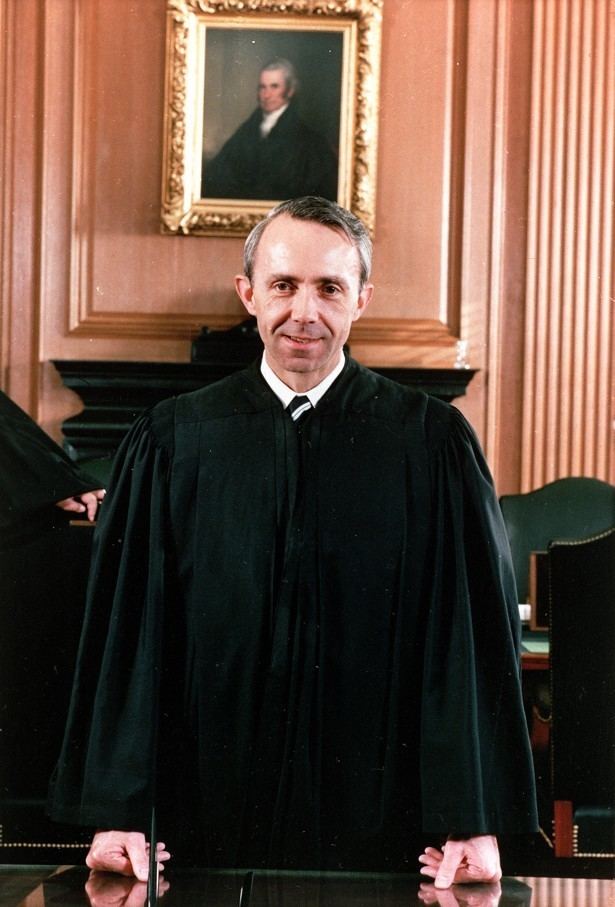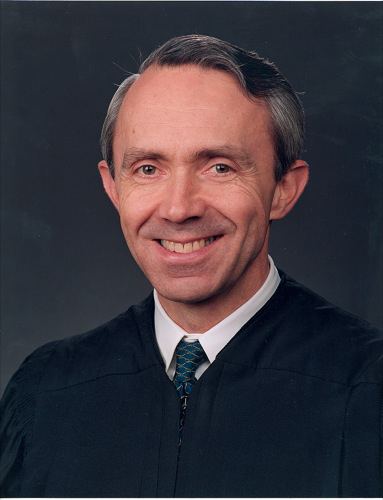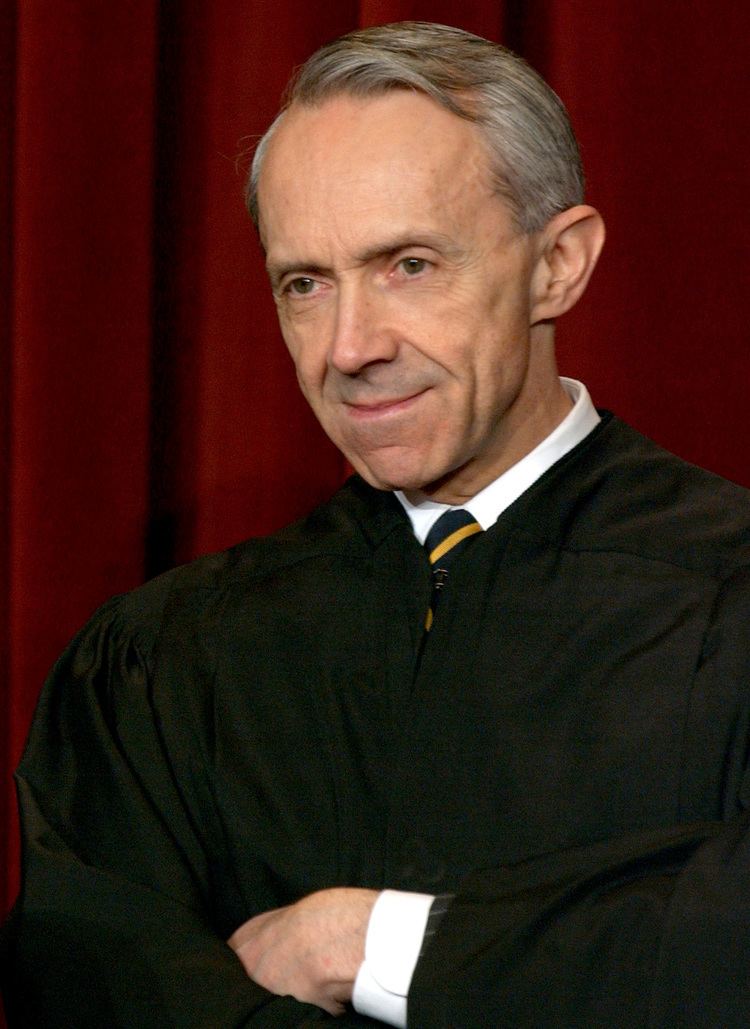Preceded by William Brennan Preceded by Maurice Paul Bois | Name David Souter | |
 | ||
Similar People | ||
Succeeded by Sherman D. Horton, Jr. Predecessor William J. Brennan, Jr. | ||
Constitutionally speaking with justice david souter and margaret warner
David Hackett Souter (; born September 17, 1939) is a retired Associate Justice of the Supreme Court of the United States. He served from October 1990 until his retirement in June 2009. Appointed by President George H. W. Bush to fill the seat vacated by William J. Brennan, Jr., Souter sat on both the Rehnquist and Roberts courts and came to vote reliably with the court's liberal members.
Contents
- Constitutionally speaking with justice david souter and margaret warner
- Supreme court justices sandra day o connor and david souter on civic education
- Early life and education
- Early career
- US Supreme Court appointment
- US Supreme Court career
- Expected conservatism
- Planned Parenthood v Casey
- Bush v Gore
- Relationship with other justices
- International recognition
- Retirement
- Post Supreme Court career
- Personal life
- References

He was the only Justice during his time on the Court with extensive prior court experience outside of a federal appeals court. He served as a prosecutor (1966–1968), in the New Hampshire Attorney General's office (1968–1976), as the Attorney General of New Hampshire (1976–1978), as an Associate Justice of the Superior Court of New Hampshire (1978–1983), as an Associate Justice of the New Hampshire Supreme Court (1983–1990) and briefly as a Judge of the United States Court of Appeals for the First Circuit (1990).

Following Souter's retirement announcement in May 2009, President Barack Obama nominated Sonia Sotomayor as his successor.

Supreme court justices sandra day o connor and david souter on civic education
Early life and education
Souter was born in Melrose, Massachusetts, on September 17, 1939, the only child of Joseph Alexander Souter (1904–1976) and Helen Adams (Hackett) Souter (1907–1995). At age 11, he moved with his family to their farm in Weare, New Hampshire.
Souter attended Concord High School in New Hampshire and went on to Harvard College, concentrating in philosophy and writing a senior thesis on the legal positivism of Supreme Court Justice Oliver Wendell Holmes Jr. In 1961, he graduated with an A.B. magna cum laude as a member of Phi Beta Kappa. He was selected as a Rhodes Scholar and earned a Bachelor of Arts degree (later promoted to a Master of Arts degree, as per tradition) from Magdalen College, Oxford, in 1963. He then entered Harvard Law School, graduating in 1966.
Early career
In 1968, after two years as an associate at the law firm of Orr & Reno in Concord, New Hampshire, Souter realized he disliked private practice and began his career in public service by accepting a position as an Assistant Attorney General of New Hampshire. As Assistant Attorney General he prosecuted criminal cases in the courts. In 1971, Warren Rudman, then the Attorney General of New Hampshire, selected Souter to be the Deputy Attorney General. Souter succeeded Rudman as New Hampshire Attorney General in 1976.
In 1978, with the support of his friend Rudman, Souter was named an Associate Justice of the Superior Court of New Hampshire. As a judge on the Superior Court he heard cases in two counties and was noted for his tough sentencing. With four years of trial court experience, Souter was appointed to the New Hampshire Supreme Court as an Associate Justice in 1983.
Shortly after George H. W. Bush was sworn in as President, he nominated Souter for a seat on the United States Court of Appeals for the First Circuit. Souter had had seven years of judicial experience at the appellate level, four years at the trial court level, and ten years with the Attorney General's office. He was confirmed by unanimous consent of the Senate on April 27, 1990.
U.S. Supreme Court appointment
President George H. W. Bush originally considered appointing Clarence Thomas to Brennan's seat, but decided that Thomas did not have enough experience as a judge. Warren Rudman, who had since been elected to the U.S. Senate, and former New Hampshire Governor John H. Sununu, then Chief of Staff to President Bush, suggested Souter, and were instrumental in his nomination and confirmation. Prior to this time, few observers outside of New Hampshire knew who Souter was, although he had reportedly been on Reagan's short list of nominees for the Supreme Court seat that eventually went to Anthony Kennedy.
Souter was seen as a "stealth justice" whose professional record in the state courts provoked little real controversy and provided very little "paper trail" on issues of U.S. Constitutional law. President Bush saw this lack of a paper trail as a positive for Souter, because one of President Reagan's nominees, Robert Bork, had recently been rejected by the Senate partially because of the availability of his extensive written opinions on controversial issues. Bush nominated Souter on July 25, 1990, saying that he did not know Souter's stances on abortion, affirmative action, or other issues.
Senate confirmation hearings were held beginning on September 13, 1990. The National Organization for Women opposed Souter's nomination and held a rally outside of the Senate during his confirmation hearings. The president of NOW, Molly Yard, testified that Souter would "end freedom for women in this country." Souter was also opposed by the NAACP, which urged its 500,000 members to write letters to their senators asking them to vote no on the nomination. In Souter's opening statement before the Judiciary Committee of the Senate he summed up the lessons he had learned as a judge of the New Hampshire courts:
The first lesson, simple as it is, is that whatever court we are in, whatever we are doing, whether we are in a trial court or an appellate court, at the end of our task some human being is going to be affected. Some human life is going to be changed in some way by what we do, whether we do it as trial judges or whether we do it as appellate judges, as far removed from the trial arena as it is possible to be. And so we had better use every power of our minds and our hearts and our beings to get those rulings right.
Despite the opposition, Souter won an easy confirmation compared to those of later appointees. The Senate Judiciary Committee reported out the nomination by a vote of 14–3, the Senate confirmed the nomination by a vote of 90–9, and Souter took his seat shortly thereafter, on October 9, 1990.
The nine senators voting against Souter included Ted Kennedy and John Kerry from Souter's neighboring state of Massachusetts. These senators, along with seven others, painted Souter as a right-winger in the mold of Robert Bork. They based their claim on Souter's friendships with many conservative politicians in New Hampshire.
U.S. Supreme Court career
Souter opposed having cameras in the Supreme Court during oral arguments because he said questions would be taken out of context by the media and the proceedings would be politicized.
He has also served as the court's designated representative to Congress on at least one occasion, testifying before committees of that body about the court's needs for additional funding to refurbish its building and for other projects.
Expected conservatism
At the time of Souter's appointment, John Sununu assured President Bush and conservatives that Souter would be a "home run" for conservatism. In his testimony before the Senate, he was thought by conservatives to be a strict constructionist on constitutional matters; however, he portrayed himself as moderate who disliked radical change and who attached a high importance to precedent. However, in the state attorney general's office and as a state Supreme Court judge, he had never been tested on matters of federal law.
Initially, from 1990 to 1992, Souter tended to be a conservative-leaning justice. In Souter's first year, Souter and Scalia voted alike close to 85 percent of the time; Souter voted with Kennedy and O'Connor about 97 percent of the time. The symbolic turning point came in two cases in 1992: Planned Parenthood v. Casey, in which the Court reaffirmed the essential holding in Roe v. Wade; and Lee v. Weisman, in which Souter voted against allowing prayer at a high school graduation ceremony. In Planned Parenthood v. Casey, Anthony Kennedy considered overturning Roe and upholding all the restrictions at issue in Casey. Souter considered upholding all the restrictions but still was uneasy about overturning Roe. After consulting with O'Connor, however, the three (who came to be known as the "troika") developed a joint opinion that upheld all the restrictions in the Casey case except for the mandatory notification of a husband while asserting the essential holding of Roe, that a right to an abortion is protected by the Constitution.
After the appointment of Clarence Thomas, Souter moved to the middle. By the late 1990s, Souter began to align himself more with Stephen Breyer and Ruth Bader Ginsburg on rulings, although as of 1995, he sided on more occasions with the more liberal justice, John Paul Stevens, than either Breyer or Ginsburg, both Clinton appointees. O'Connor began to move to the center. On death penalty cases, worker rights cases, criminal rights cases, and other issues, Souter began voting with the liberals in the court. So while appointed by a Republican president and thus expected to be conservative, Souter came to be considered part of the liberal wing of the court. Because of this, many conservatives view the Souter appointment as a major error on the part of the Bush administration and have gone on to intensely scrutinize future potential Republican appointees on the standard of whether they would be reliable conservatives. For example, after widespread speculation that President George W. Bush intended to appoint Alberto Gonzales—whose perceived views on affirmative action and abortion drew criticism—to the court, some conservative Senate staffers popularized the slogan that "Gonzales is Spanish for Souter".
An opinion article by The Wall Street Journal some ten years after the Souter nomination called Souter a "liberal jurist" and said that Rudman took "pride in recounting how he sold Mr. Souter to gullible White House Chief of Staff John Sununu as a confirmable conservative. Then they both sold the judge to President Bush, who wanted above all else to avoid a confirmation battle." Rudman wrote in his memoir that he had "suspected all along" that Souter would not "overturn activist liberal precedents." Sununu later said that he had "a lot of disappointment" about Souter's positions on the court and would have preferred him to be more similar to Justice Antonin Scalia.
Planned Parenthood v. Casey
In 1992's Planned Parenthood v. Casey, Souter wrote that Roe v. Wade should not be overturned because it would be "a surrender to political pressure... So to overrule under fire in the absence of the most compelling reason to re-examine a watershed decision would subvert the Court's legitimacy beyond any serious question."
Bush v. Gore
In 2000, Souter voted and dissented along with three other justices in Bush v. Gore to allow the presidential election recount to continue while the majority voted to end the recount. The majority decision allowed the declaration of Bush as the winner of the election in Florida to stand.
Jeffrey Toobin wrote, controversially, of Souter's reaction to Bush v. Gore in his 2007 book The Nine:
Toughened, or coarsened, by their worldly lives, the other dissenters could shrug and move on, but Souter couldn't. His whole life was being a judge. He came from a tradition where the independence of the judiciary was the foundation of the rule of law. And Souter believed Bush v. Gore mocked that tradition. His colleagues' actions were so transparently, so crudely partisan that Souter thought he might not be able to serve with them anymore. Souter seriously considered resigning. For many months, it was not at all clear whether he would remain as a justice. That the Court met in a city he loathed made the decision even harder. At the urging of a handful of close friends, he decided to stay on, but his attitude toward the Court was never the same. There were times when David Souter thought of Bush v. Gore and wept.
The above passage was, however, disputed by Souter's long-time friend, Warren Rudman. Rudman told the New Hampshire Union Leader that while Souter was discomfited by Bush v. Gore, the idea that he had broken down into tears over the matter was not true.
Relationship with other justices
Souter worked well with Sandra Day O'Connor and had a good relationship with both her and her husband during her days on the court. He generally had a good working relationship with each justice on the court, but was particularly fond of Ruth Bader Ginsburg, and considered John Paul Stevens to be the "smartest" justice.
International recognition
Even though Souter had never traveled outside the United States during his years with the Supreme Court, he still had gained quite a recognition abroad. In 1995, a series of articles, based on his written opinions and entitled "Souter Court", was published by a Moscow legal journal The Russian Justice. Those were followed by a book, written in Russian and bearing Souter's name in the title. Justice of the Constitutional Court of the Russian Federation Yury Danilov, reviewing the 2nd edition of the book in a Moscow English-language daily, made the following remark on Souter's position in Bush v. Gore: "In a most critical and delicate situation, David Souter had maintained the independence of his position and in this respect had become a symbol of the independence of the judiciary."
Retirement
Long before the election of President Obama, Souter had expressed a desire to leave Washington, D.C., and return to his native New Hampshire. The election of a Democratic president in 2008 made Souter more inclined to retire, but he did not want to create a situation in which there would be multiple vacancies at once. Souter apparently became satisfied that no other justices planned to retire at the end of the Supreme Court's term in June 2009. As a result, in mid-April 2009 he privately notified the White House of his intent to retire from the Supreme Court at the conclusion of its business for that term. Souter sent a retirement letter to President Obama on May 1, effective at the start of the Supreme Court's 2009 summer recess. Later that day President Obama made an unscheduled appearance during the daily White House press briefing to publicly announce Souter's retirement. On May 26, 2009, Obama announced his selection of federal appeals court judge Sonia Sotomayor as the nominee. She was confirmed by the U.S. Senate on August 6.
On June 29, 2009, the last day of the Court's 2008–2009 term, Chief Justice Roberts read a letter to Souter that had been signed by all eight of his colleagues as well as retired Justice Sandra Day O'Connor, thanking him for his service, and Souter read a letter to his colleagues reciprocating their good wishes.
Souter, Sandra Day O'Connor, and John Paul Stevens are, as of 2017, the Supreme Court's only living former justices.
Post-Supreme Court career
As a Supreme Court justice with retired status, Souter remains a judge and is entitled to sit by designation on lower courts. Since his retirement from the Supreme Court, he regularly sits by designation on panels of the First Circuit Court of Appeals, based in Boston and covering Maine, Massachusetts, Puerto Rico, Rhode Island, and his native New Hampshire, generally in February or March of each year.
Personal life
Once named by The Washington Post as one of Washington's 10 Most Eligible Bachelors, Souter has never married, though he was once engaged.
According to Jeffrey Toobin's 2007 book The Nine, Souter has a decidedly low-tech lifestyle: He writes with a fountain pen, does not use e-mail, and has no cell phone or answering machine. While he was serving on the Supreme Court, he preferred to drive back to New Hampshire for the summer where he enjoyed mountain climbing. Souter has also done his own home repairs and is known for his daily lunch of an apple and yogurt.
Souter has been described by former Supreme Court correspondent Linda Greenhouse as the following: "but to focus on his eccentricities — his daily lunch of yogurt and an apple, core and all; the absence of a computer in his personal office — is to miss the essence of a man who in fact is perfectly suited to his job, just not to its trappings. His polite but persistent questioning of lawyers who appear before the court displays his meticulous preparation and his mastery of the case at hand and the cases relevant to it. Far from being out of touch with the modern world, he has simply refused to surrender to it control over aspects of his own life that give him deep contentment: hiking, sailing, time with old friends, reading history."
In early August 2009, Souter moved from his family farm house in Weare to a Cape Cod-style single-floor home on two well-manicured acres in Hopkinton, New Hampshire, a town adjacent to the state capital of Concord. Souter told a disappointed Weare neighbor that the two-story family farmhouse was not structurally sound enough to support the thousands of books he owns, and that he wished to live on one level.
Over the years, Souter has served on hospital boards and civic committees. He is a former honorary co-chair of the We the People National Advisory Committee.
